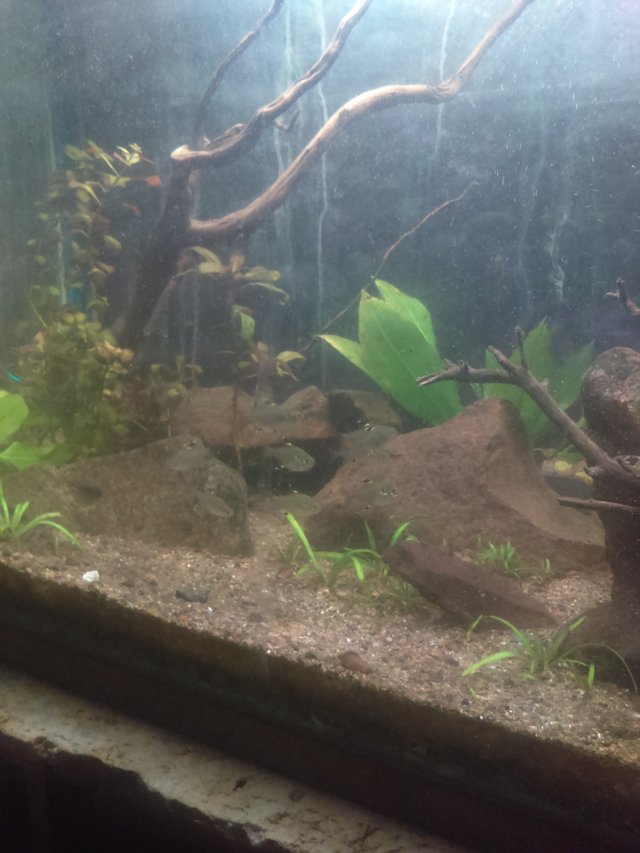This method of setting up an aquarium tank was made popular by Diana Walstad, author of the book 'ECOLOGY of the PLANTED AQUARIUM - A Practical Manual and Scientific Treatise for the Home Aquarist'.
Basically it's a natural planted tank with a substrate containing a soil underlayer.
Alternative names
El Natural, NPT (Natural Planted Tank), Walstad Tank.
Principles
Provide an ecosystem where plants and fish balance each other's needs. The soil underlayer ensures that plants grow well enough to out-compete algae and recycle fish waste and toxins (e.g., ammonia, nitrite, etc.). Without soil, plants don't grow well enough to do "their job".
Aims
Good plant growth
No injected CO2 required
No or little algae
No need for plant fertilizers
Supplies trace elements for fish health
Stable environment for your pets
No need to vacuum the substrate
No need for frequent water changes—once the tank is established
A smell-free tank.
Biofilter may not be required (plants will take care of the ammonia, nitrite and nitrate, and the soil bacteria will also consume nitrogen).
Principle steps
3 Litre Walstad tank set up in one day with shrimp
1 inch layer of inexpensive, generic potting soil (or "top soil") available from any garden centres or various home improvement stores. (John Innes number 3 recipe is ideal). Avoid soils containing chemical fertilizers (sulphates and nitrates will be converted to toxic H2S and nitrite after soil is submerged). Phosphate and calcium fertilizers (i.e., a little bone meal mixed with soil) may be beneficial. Get non-sterile 'aquatic pond soil' if it's available.
Soil based compost - John Innes #3
1 inch of medium fine gravel (or very shallow layer of sand) to cover the soil layer (the soil bacteria need oxygen, so don't smother the soil layer with rocks, driftwood, etc)
If you have soft-water, you can mix in a calcium source (lime, coral gravel, shells, bone meal, etc) with the soil to make sure plants get enough calcium, GH for their initial set-up.
For tank set-up, start out with many species of fast-growing plants (you want to find the ones that adapt best to your tank's conditions). Examples: Hygrophila corymbosa, Shinnersia riv., Rotala rotundifolia, Ludwigia repens, Limnophila sessiliflora, Hornwort, Riccia, etc.
Provide adequate lighting. This should be at least 2W per US Gallon (3.8L) of fluorescent lighting over the length of the tank for a period of at least 10 hours a day. 'Cool white' tubes are usually all that is required. If you can position the tank so that it can get a little sunlight for at least an hour a day, then do so (make sure water doesn't overheat). Diana recommends a mid-day siesta [1], and uses a 5 hour on, 4 hours off, 5 hours on photoperiod on her own tanks. The dark period allows CO2 levels to rise which promotes plant growth and inhibits algae growth.
Add room temperature conditioned (no chlorine or chloramine) water. Or add water conditioner right away.
Provide enough water movement (via filters, power-heads, etc) to keep the water safely oxygenated for fish and soil bacteria. (Keeping water safely oxygenated is especially important the first two months with a freshly submerged soil). Water circulation near the water surface will break up possible bio-film development.
Test water every two days for pH, ammonia, nitrite and nitrate (for at least two months or until you are sure they have gone). There may be a temporary increase in these levels while the soil is getting established (first 2 months), especially if the soil was artificially fertilized. Consider the use of Prime or Amquel daily to remove any potential total ammonia that may develop in the initial two months.
If there are signs of algae, temporarily reduce lighting levels slightly or add floating plants. Main goal is to get plants growing well enough to out-compete algae.
Do water changes as needed [some soils often require frequent water changes the first two months to remove miscellaneous toxins (e.g., wood oils) released by the soil. Also, new soils invariably release algae-stimulating nutrients (Nitrogen) the first couple months.] After tank is established, water changes can be very infrequent.
You can add aquatic animals same day after set-up, but closely monitor fish health. It may be necessary (though unusual) during this "soil break-in period" to do some water changes to lower tannins. Some people use activated carbon in the filter if you wish to remove any yellow tannin effect (but realise these tannins are a health benefit to the tank animals.
Monitor ammonia/nitrite levels for the first month. If you get any level above zero, act on them - perform a 25% water change! However if you add Prime or AmQuel+ daily for a month, you'll protect the tank occupants against any possible harm from ammonia/nitrite and eliminate this chore.
Hi! I am a robot. I just upvoted you! I found similar content that readers might be interested in:
http://www.theaquariumwiki.com/wiki/Walstad_method
Downvoting a post can decrease pending rewards and make it less visible. Common reasons:
Submit
Congratulations @bubblegummyke! You have completed some achievement on Steemit and have been rewarded with new badge(s) :
Click on the badge to view your Board of Honor.
If you no longer want to receive notifications, reply to this comment with the word
STOPDo not miss the last post from @steemitboard!
Participate in the SteemitBoard World Cup Contest!
Collect World Cup badges and win free SBD
Support the Gold Sponsors of the contest: @good-karma and @lukestokes
Downvoting a post can decrease pending rewards and make it less visible. Common reasons:
Submit
Congratulations @bubblegummyke! You received a personal award!
You can view your badges on your Steem Board and compare to others on the Steem Ranking
Vote for @Steemitboard as a witness to get one more award and increased upvotes!
Downvoting a post can decrease pending rewards and make it less visible. Common reasons:
Submit